CHEVROLET CORVETTE 1995 4.G Owners Manual
Manufacturer: CHEVROLET, Model Year: 1995, Model line: CORVETTE, Model: CHEVROLET CORVETTE 1995 4.GPages: 386, PDF Size: 20.15 MB
Page 281 of 386
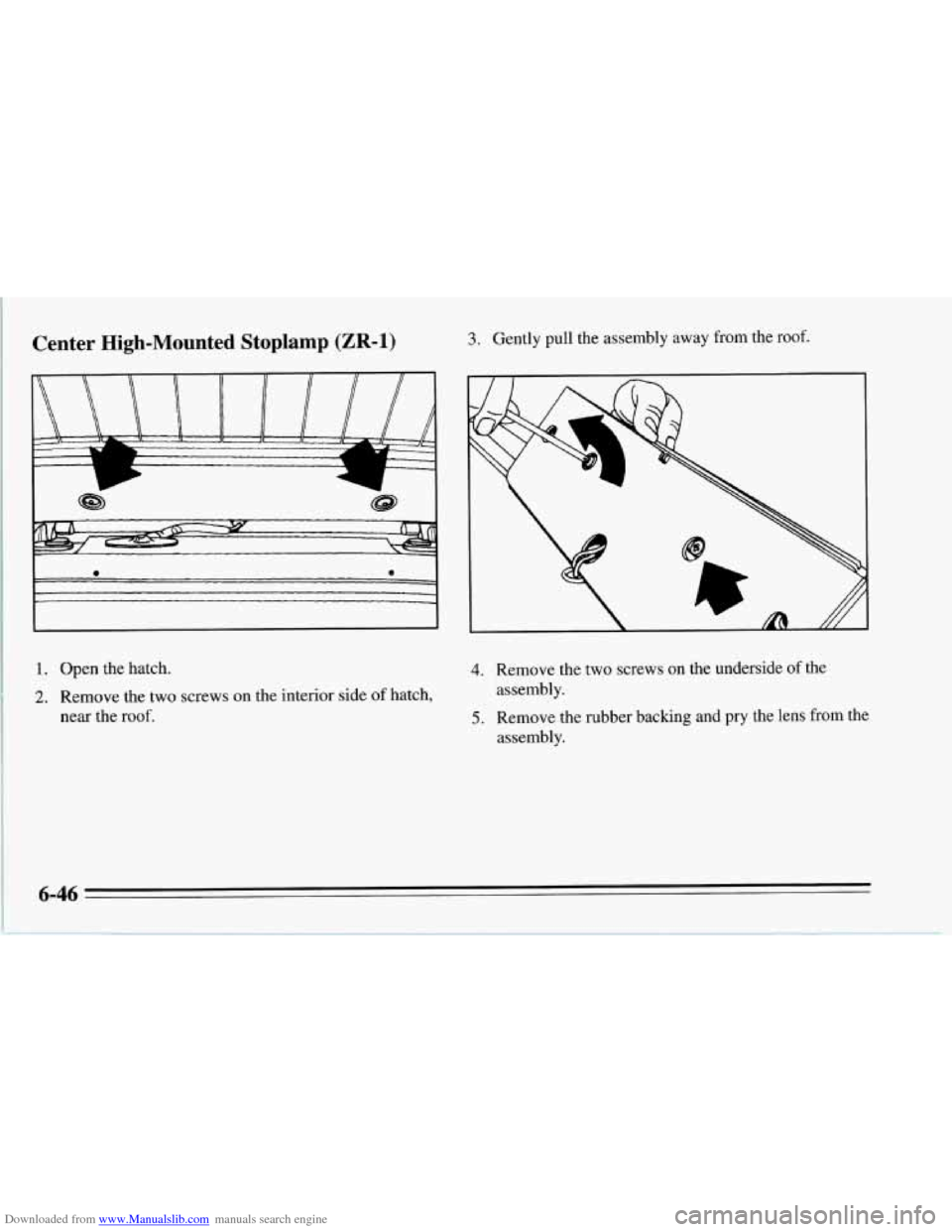
Downloaded from www.Manualslib.com manuals search engine Center High-Mounted Stoplamp (ZR-1)
A
1. Open the hatch.
2. Remove the two screws on the interior side of hatch,
near the roof.
3. Gently pull the assembly away from the roof.
4. Remove the two screws on the underside of the
assembly.
5. Remove the rubber backing and pry the lens from the
assembly.
6-46
Page 282 of 386

Downloaded from www.Manualslib.com manuals search engine Windshield Wiper Blades
6. Rock the bulb back and forth while pulling up to
remove it.
7. Reverse the steps with a new bulb. It’s a good idea to clean or replace the wiper blade assembly
every
six months. To remove the wiper blade assembly:
1. Open the hood to gain access to the windshield wipers.
2. Insert a screwdriver into the RELEASE slot (A) on
the wiper arm. (There’s an arrow on the wiper arm
pointing
to the slot.)
3. Push down gently to release the wiper blade
assembly
(B) from the arm.
4. Reverse the steps to install the assembly.
6-47
Page 283 of 386
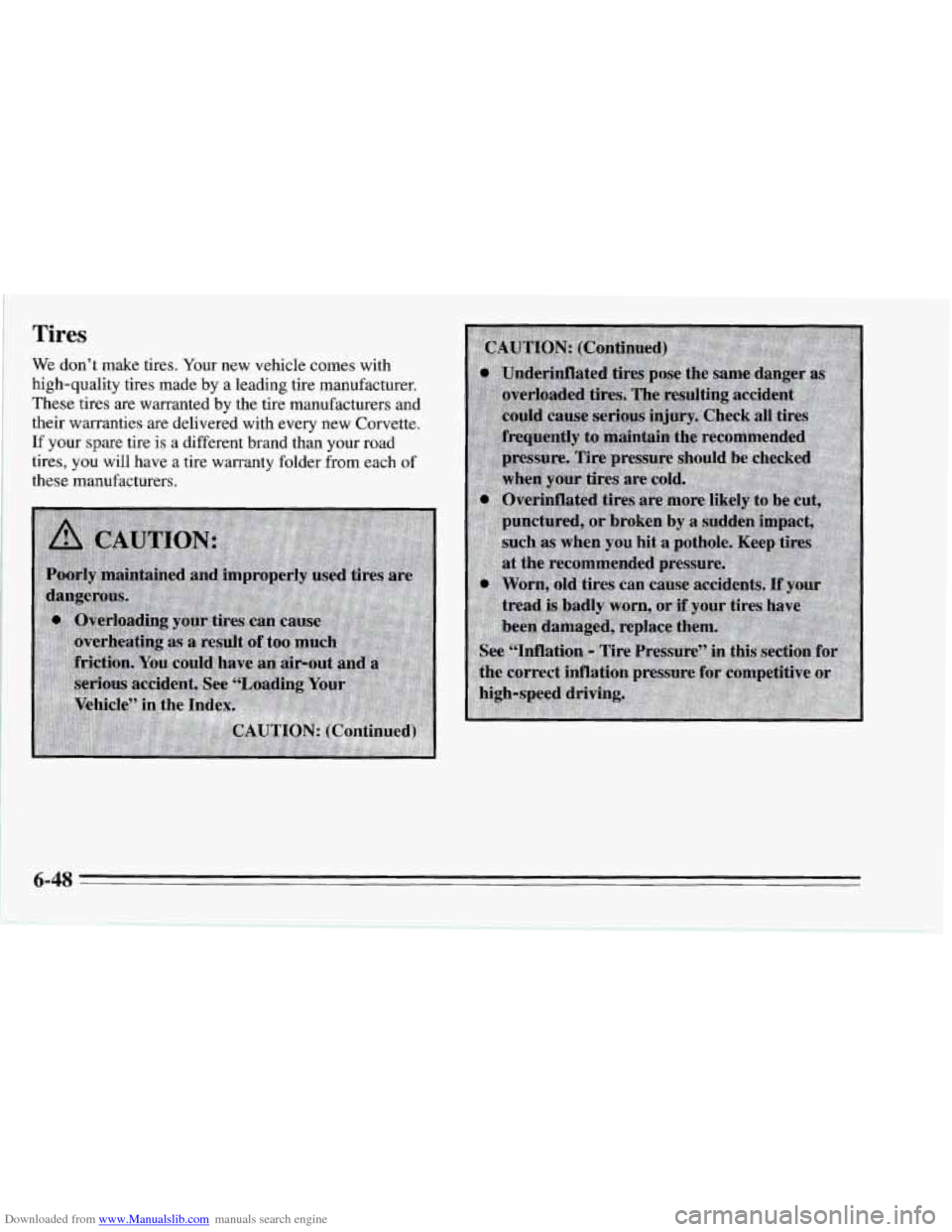
Downloaded from www.Manualslib.com manuals search engine Tires
We don’t make tires. Your new vehicle comes with
high-quality tires made by a leading tire manufacturer.
These tires are warranted
by the tire manufacturers and
their warranties are delivered with every new Corvette.
If your spare tire is
a different brand than your road
tires, you will have a tire warranty folder from each of
these manufacturers.
6-48
Page 284 of 386
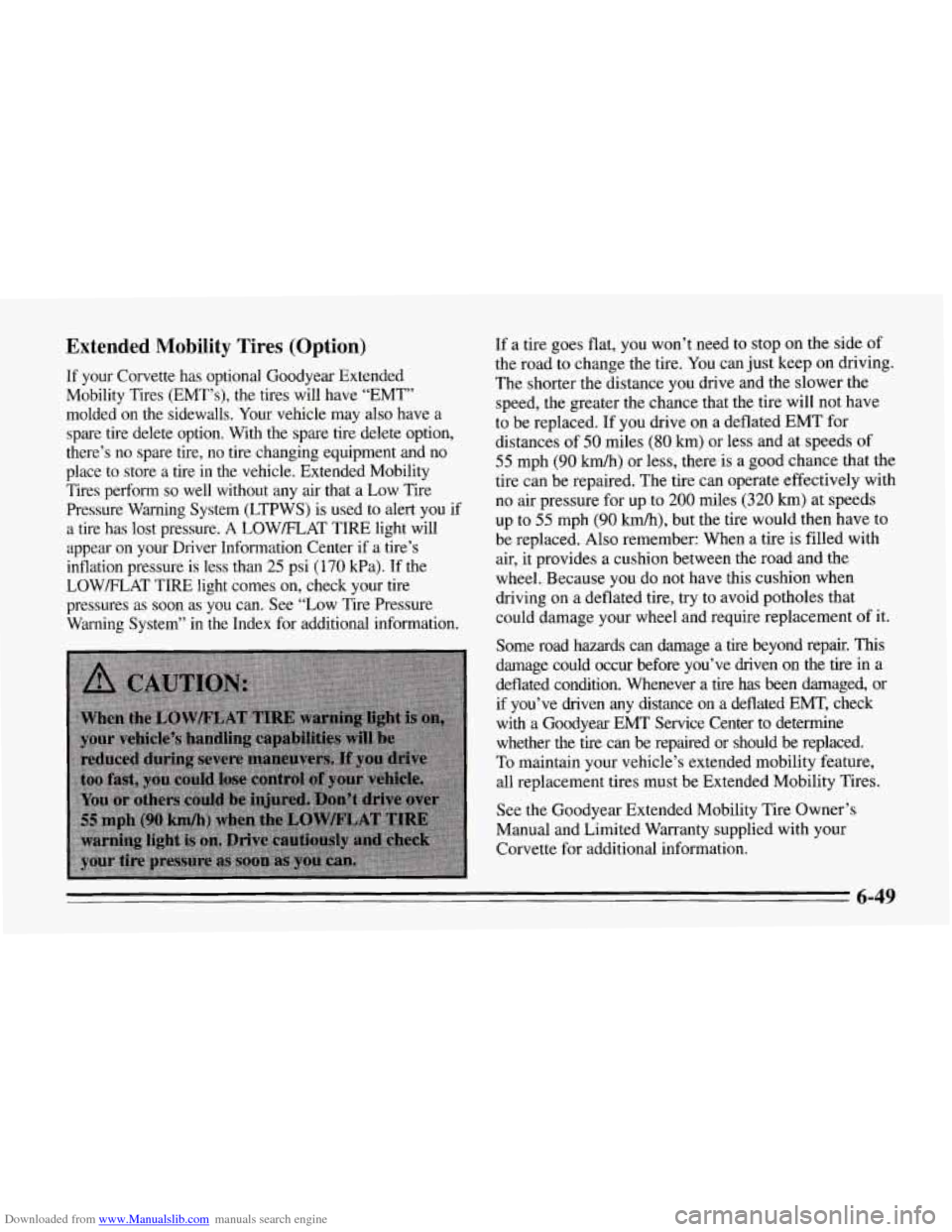
Downloaded from www.Manualslib.com manuals search engine Extended Mobility Tires (Option)
If your Corvette has optional Goodyear Extended
Mobility Tires (EMT’s), the tires will have “EMT”
molded on the sidewalls. Your vehicle may also have a
spare tire delete option. With the spare tire delete option,
there’s no spare tire, no tire changing equipment and no
place to store a tire in the vehicle. Extended Mobility
Tires perform
so well without any air that a Low Tire
Pressure Warning System (LTPWS) is used to alert you if
a tire has lost pressure.
A LOWELAT TIRE light will
appear on your Driver Information Center
if a tire’s
inflation pressure is less than
25 psi (170 kPa). If the
LOW/FLAT
TIRE light comes on, check your tire
pressures as soon as you can. See “Low Tire Pressure
Warning System” in the Index for additional information. If a
tire goes flat,
you won’t need to stop on the side of
the road to change the tire. You can just keep on driving.
The shorter the distance
you drive and the slower the
speed, the greater the chance that the tire will not have
to be replaced. If
you drive on a deflated EMT for
distances
of 50 miles (80 km) or less and at speeds of
55 mph (90 km/h) or less, there is a good chance that the
tire can be repaired. The tire can operate effectively with
no air pressure for up to 200 miles (320 km) at speeds
up to
55 mph (90 kmk), but the tire would then have to
be replaced. Also remember: When a tire is filled with
air, it provides a cushion between the road and the
wheel. Because you do not have this cushion when
driving on a deflated tire, try to avoid potholes that
could damage your wheel and require replacement of it.
Some road hazards can damage a tire beyond repair. This
damage could occur before you’ve driven on the tire
in a
deflated condition. Whenever a tire has been damaged, or
if you’ve driven any distance on a deflated EMT, check
with a Goodyear EMT Service Center to determine
whether
the tire can be repaired or should be replaced.
To maintain your vehicle’s extended mobility feature,
all replacement tires must be Extended Mobility Tires.
See the Goodyear Extended Mobility Tire Owner’s
Manual and Limited Warranty supplied with your
Corvette for additional information.
6-49
Page 285 of 386

Downloaded from www.Manualslib.com manuals search engine Inflation - Tire Pressure
The Tire-Loading Information label which is on the
driver’s door shows the correct inflation pressures for
your tires, when they’re cold. “Cold” means your
vehicle has been sitting for at least three hours or driven
no more than a mile.
For competitive driving or high-speed driving (over
150 mph or 240 km/h), make sure your tires are inflated
to
35 psi (240 Wa). When you end this type of driving,
reduce the “cold” inflation pressures
(if necessary) to
those listed on the Tire-Loading Information label.
I
I NOTICE:
Don’t let anyone tell you that underinflation or
overidation is
all right. It’s not. If your tires don’t
have enough
air (underinflation) you can get:
Too much flexing
0 Too much heat
Tire overloading
Bad wear
0 Bad handling
0 Bad fuel economy.
(Continued)
I I
I NOTICE: (Continued)
If your tires have too much air (overinflation),
you can get:
0 Unusual wear
0 Bad handling
0 Rough ride
0 Needless damage from road hazards.
1
When to Check
Check your tires once a month or more.
Don’t forget your compact spare tire. It should be at
60 psi (420 Wa).
How to Check
Use a good quality pocket-type gage to check tire
pressure. Simply looking at the tires will not tell you the
pressure, especially if you have radial tires
-- which
may look properly inflated even if they’re underinflated.
If your tires have valve caps, be sure to put them back
on. They help prevent leaks by keeping out dirt and
moisture.
6-50
Page 286 of 386

Downloaded from www.Manualslib.com manuals search engine Tire Rotation
The tires on your Corvette are directional, asymmetrical,
and are different sizes front to rear. Due to this, your
tires should not be rotated. Each tire and wheel should
be used only in the position it is in.
When it’s Time for New Tires
One way to tell when it’s time for new tires is to check
the treadwear indicators, which will appear when your
tires have only
1/16 inch (1.6 mm) or less of tread
remaining. You
need a new tire
if
You can see the indicators at three or more places
You can see cord or fabric showing through the tire’s
0 The tread or sidewall is cracked, cut or snagged deep
enough
to show cord or fabric.
The tire has a bump, bulge or split.
0 The tire has a puncture, cut, or other damage that
around
the tire.
rubber.
can’t be repaired well because
of the size or location
of the damage.
6-51
Page 287 of 386
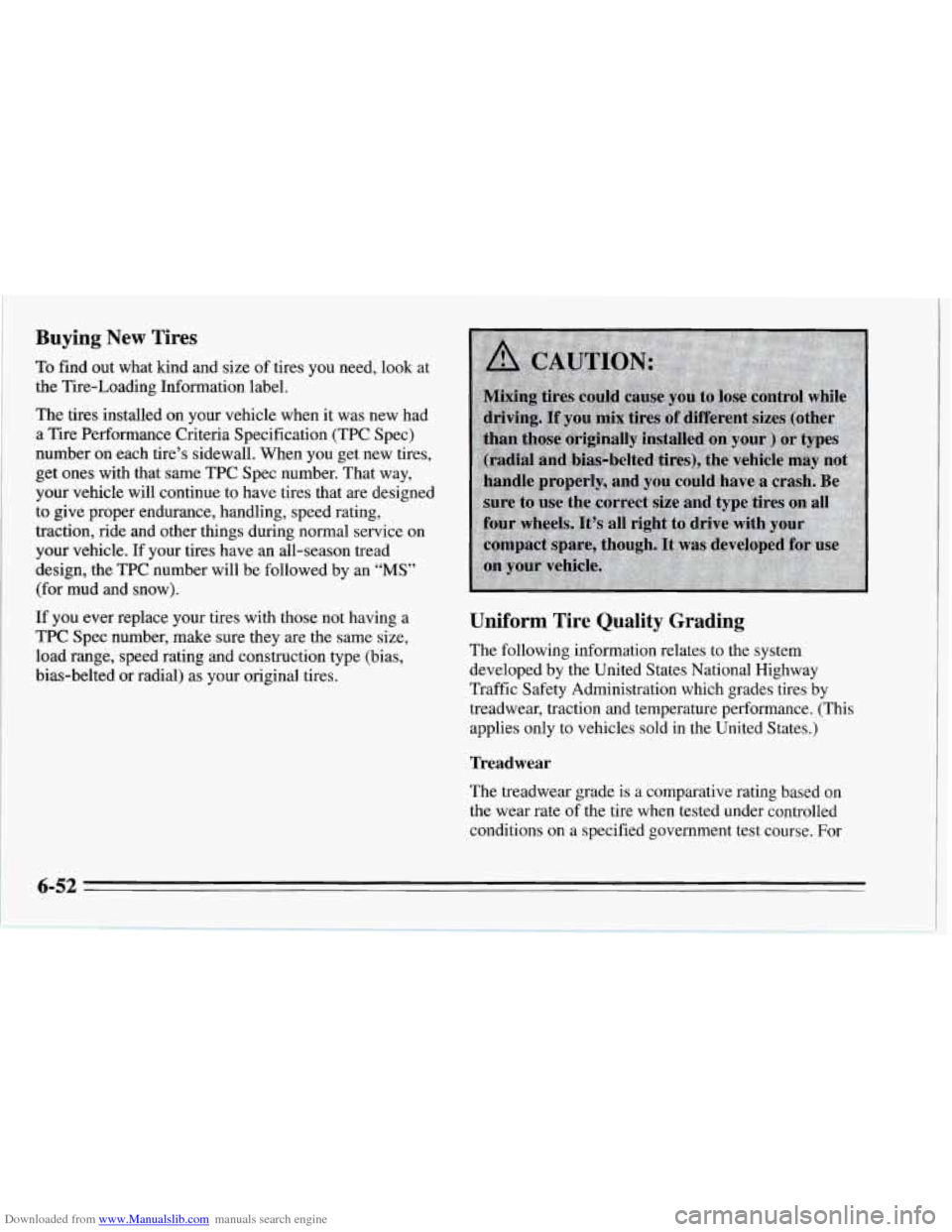
Downloaded from www.Manualslib.com manuals search engine Buying New Tires
To find out what kind and size of tires you need, look at
the Tire-Loading Information label.
The tires installed on your vehicle when it was new had
a Tire Performance Criteria Specification (TPC Spec)
number on each tire’s sidewall. When you get new tires,
get ones with that same TPC Spec number. That way,
your vehicle will continue to have tires that are designed
to give proper endurance, handling, speed rating,
traction, ride and other things during normal service on
your vehicle. If your tires have an all-season tread
design, the TPC number will be followed by an
“MS”
(for mud and snow).
If you ever replace your tires with those not having a
TPC Spec number, make sure they are the same size,
load range, speed rating and construction type (bias,
bias-belted or radial) as your original tires.
Uniform Tire Quality Grading
The following information relates to the system
developed
by the United States National Highway
Traffic Safety Administration which grades tires by
treadwear, traction and temperature performance. (This
applies only to vehicles sold in the United States.)
Treadwear
The treadwear grade is a comparative rating based on
the wear rate of the tire when tested under controlled
conditions on
a specified government test course. For
6-52
Page 288 of 386
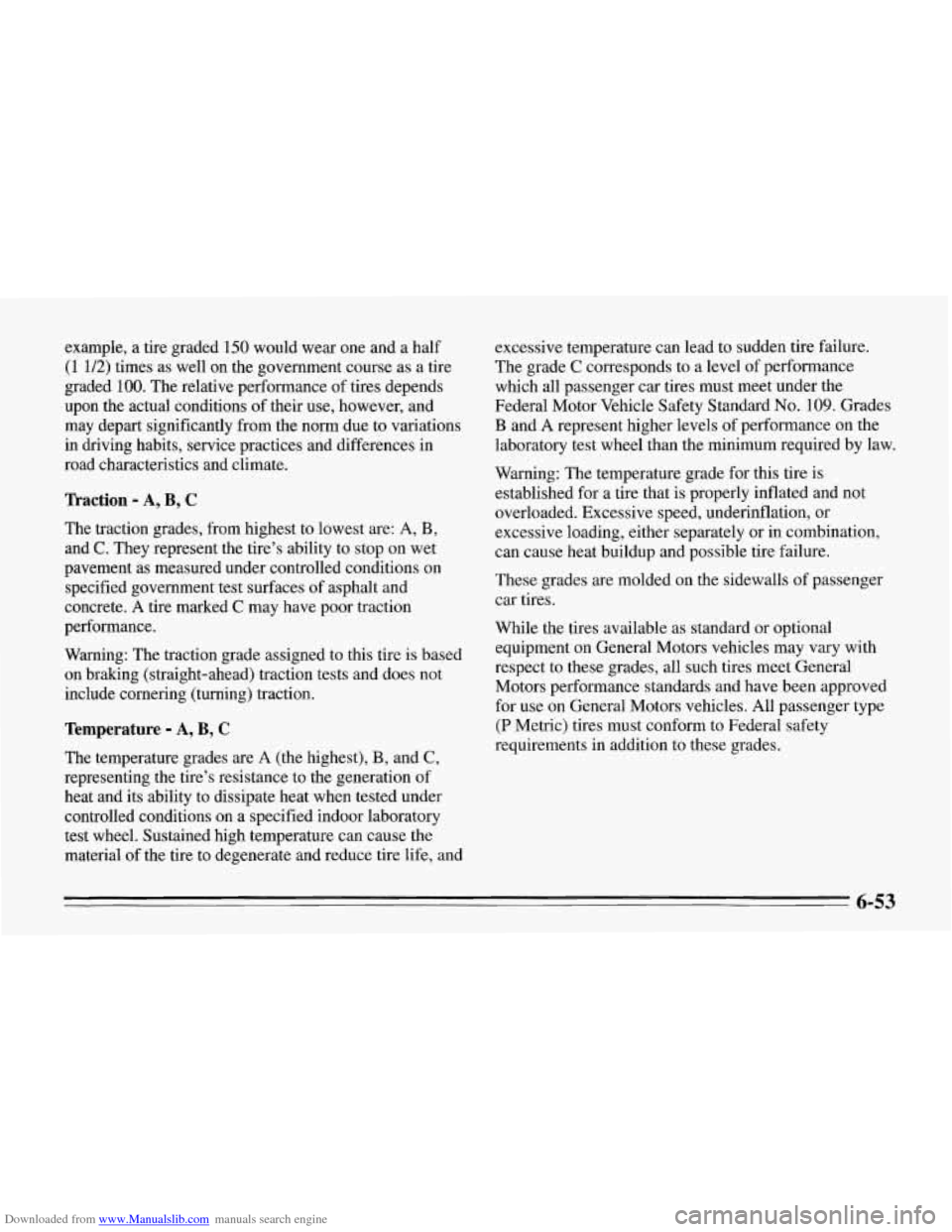
Downloaded from www.Manualslib.com manuals search engine example, a tire graded 150 would wear one and a half
(1 1/2) times as well on the government course as a tire
graded
100. The relative performance of tires depends
upon the actual conditions of their use, however, and
may depart significantly from the norm due to variations
in driving habits, service practices and differences in
road characteristics and climate.
Traction - A, B, C
The traction grades, from highest to lowest are: A, B,
and C. They represent the tire’s ability to stop on wet
pavement as measured under controlled conditions on
specified government test surfaces of asphalt and
concrete.
A tire marked C may have poor traction
performance.
Warning: The traction grade assigned to this tire is based
on braking (straight-ahead) traction tests and does not
include cornering (turning) traction.
Temperature - A, B, C
The temperature grades are A (the highest), B, and C,
representing the tire’s resistance to the generation of
heat and its ability to dissipate heat when tested under
controlled conditions on a specified indoor laboratory
test wheel. Sustained high temperature can cause the
material of the tire to degenerate and reduce tire life, and excessive
temperature can lead to sudden tire failure.
The grade
C corresponds to a level of performance
which all passenger car tires must meet under the
Federal Motor Vehicle Safety Standard
No. 109. Grades
B and A represent higher levels of performance on the
laboratory test wheel than the minimum required by law.
Warning: The temperature grade for this tire is
established for a tire that is properly inflated and not
overloaded. Excessive speed, underinflation, or
excessive loading, either separately or in combination,
can cause heat buildup and possible tire failure.
These grades are molded on the sidewalls of passenger
car tires.
While the tires available as standard or optional
equipment on General Motors vehicles may vary with
respect to these grades, all such tires meet General
Motors performance standards and have been approved
for use on General Motors vehicles. All passenger type
(P Metric) tires must conform to Federal safety
requirements in addition to these grades.
6-53
Page 289 of 386
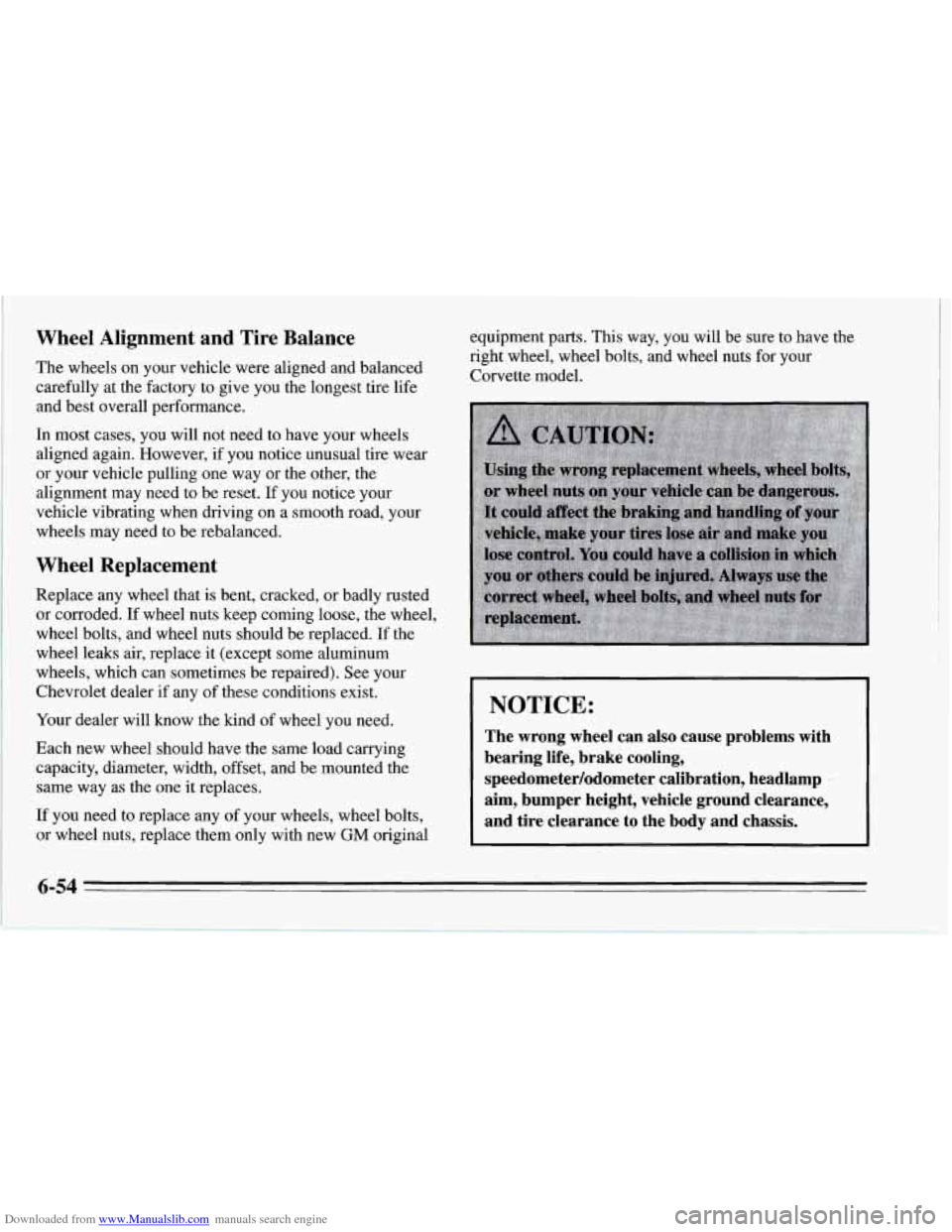
Downloaded from www.Manualslib.com manuals search engine Wheel Alignment and Tire Balance
The wheels on your vehicle were aligned and balanced
carefully at the factory
to give you the longest tire life
and best overall performance.
In most cases, you will not need to have your wheels
aligned again. However,
if you notice unusual tire wear
or your vehicle pulling one way or the other, the
alignment may need to be reset.
If you notice your
vehicle vibrating when driving
on a smooth road, your
wheels may need to be rebalanced.
Wheel Replacement
Replace any wheel that is bent, cracked, or badly rusted
or corroded. If wheel nuts keep coming loose, the wheel,
wheel bolts, and wheel nuts should be replaced.
If the
wheel leaks air, replace it (except some aluminum
wheels, which can sometimes be repaired). See your
Chevrolet dealer
if any of these conditions exist.
Your dealer will know the lund of wheel you need.
Each new wheel should have the same load carrying capacity, diameter, width, offset, and be mounted the
same way as the one it replaces.
If you need to replace any of your wheels, wheel bolts,
or wheel nuts, replace them only with new
GM original equipment parts.
This way, you will be sure to have the
right wheel, wheel bolts, and wheel nuts for your
Corvette model.
I NOTICE:
The wrong wheel can also cause problems with
bearing life, brake cooling,
speedometer/odometer calibration, headlamp aim, bumper height, vehicle ground clearance,
and tire clearance to the body and chassis.
6-54
Page 290 of 386
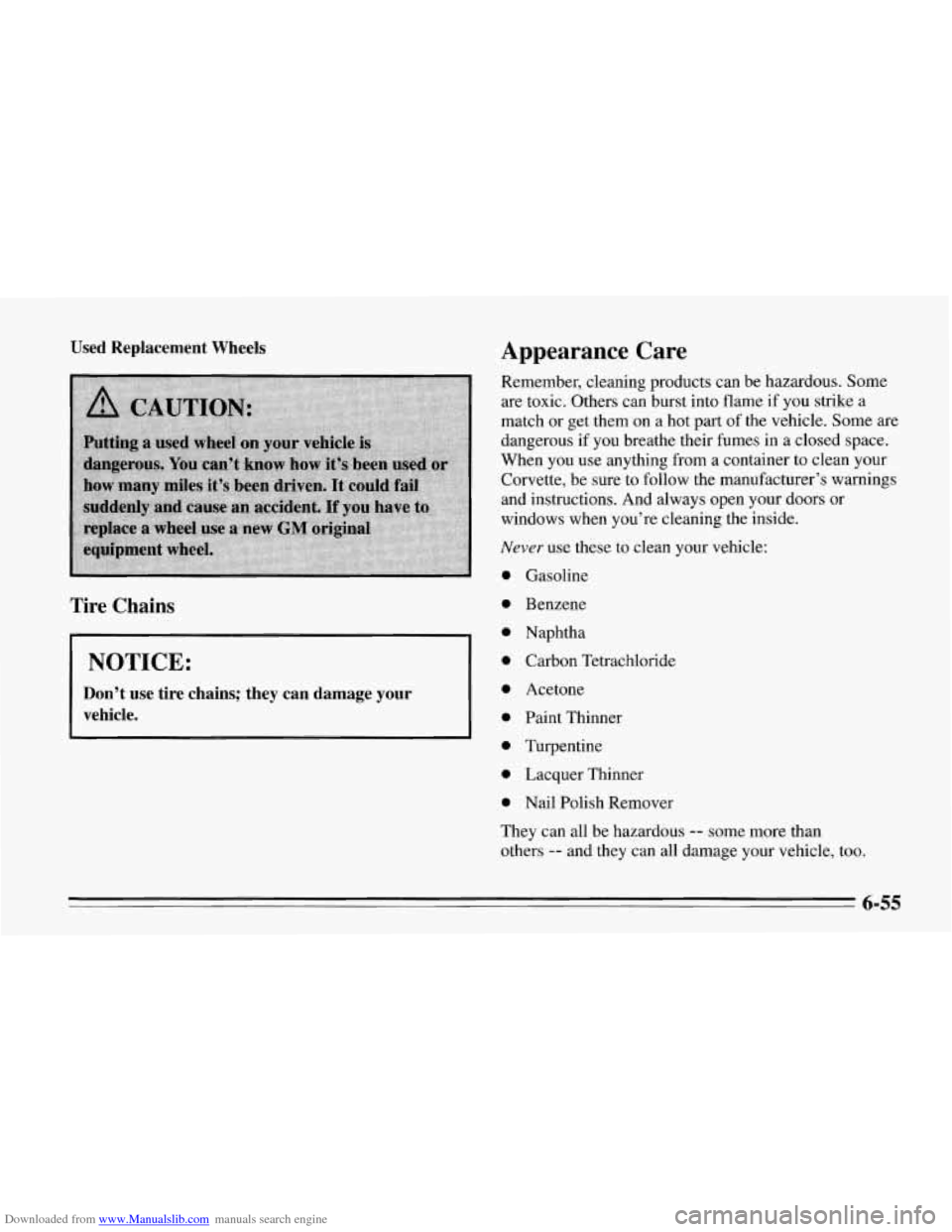
Downloaded from www.Manualslib.com manuals search engine Used Replacement Wheels
Tire Chains
NOTICE:
Don’t use tire chains; they can damage your
vehicle.
Appearance Care
Remember, cleaning products can be hazardous. Some
are toxic. Others can burst into flame if you strike a
match or get them on a hot part of the vehicle. Some are
dangerous if you breathe their fumes in a closed space.
When you use anything from a container to clean your
Corvette, be sure to follow the manufacturer’s warnings
and instructions. And always open your doors
or
windows when you’re cleaning the inside.
Never use these to clean your vehicle:
0
0
0
0
0
0
0
0
0
Gasoline
Benzene Naphtha
Carbon Tetrachloride
Acetone
Paint Thinner
Turpentine
Lacquer Thinner
Nail Polish Remover
They can all be hazardous
-- some more than
others
-- and they can all damage your vehicle, too.
6-55